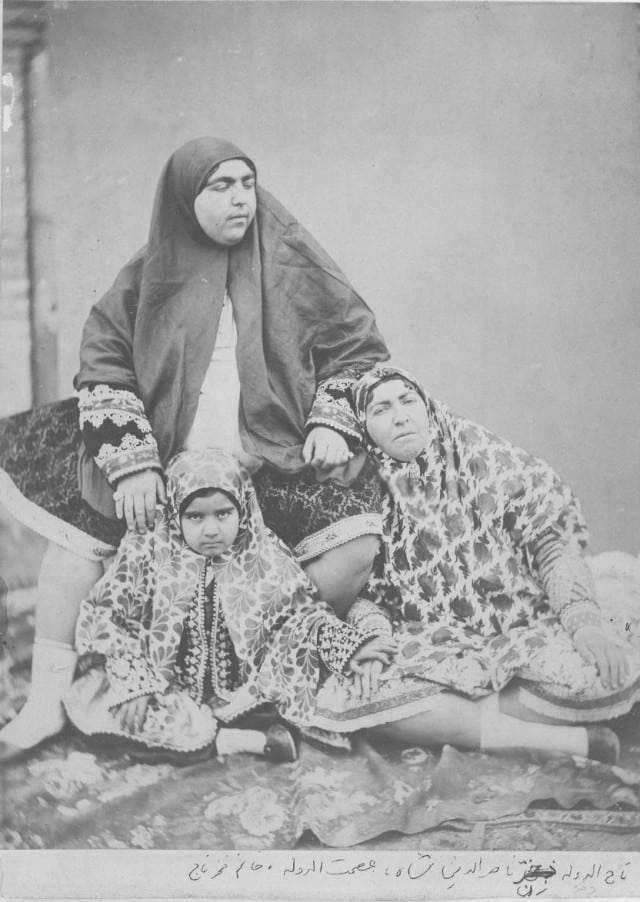A “Princess Qajar” history meme has been making the rounds on the internet for years. It shows a Persian princess with a mustache claiming that she was a symbol of beauty in the 19th century, and many men committed suicide after she rejected them.
The vagueness of this claim and its perceived unlikelihood has made it go viral many times. While Princess Qajar may or may not have been a Persian beauty symbol due to the different beauty standards of that region and era, there is much more to her story.

Who was Princess Qajar?
The woman memes call Princess Qajar is Zahra Khanom Tadj es-Saltaneh, and she was born in 1883. Her father was Naser al-Din Shah Qajar, the King of Persia. The Qajar Dynasty ruled over Iran from 1789 to 1925.
Princess Qajar was extremely accomplished. She was a painter, writer, musician, intellectual, and activist.
Her memoirs are an important historical document to this day. She hosted weekly literary salons and was fluent in Arabic, French, and her native Farsi.
More impressively, she was a founding member of Anjoman Horriyyat Nsevan, a Persian women’s rights group. She would secretly host meetings and was the first woman to take off her hijab in court and wear women’s clothes. She even led a women’s rights march to parliament and supported Iran’s constitutional revolution.
Princess Qajar also was a prominent critic of her father’s oppressive regime. She blamed Persia’s problems, like the lack of education, the unequal treatment of women, and poverty, on her family. She was one of the few women fighting for change in Persia at the time.

Princess Qajar’s Early Life and Marriage
Her belief in women’s rights stemmed from her early life. In her memoirs, she discussed growing up in the royal harem and the slaves’ horrible treatment. Also, this fueled her later criticisms of Persia.
Tadj Saltaneh’s betrothal at eight caused her a significant amount of pain. When she was 13 years old, she was married off to Sardar Hassan Shojah Saltaneh, her father’s defense minister’s son.
They had four children, two sons, and two daughters before she divorced her husband. Divorce was incredibly taboo at the time, but she couldn’t take her husband’s constant extramarital affairs.
She lived out her remaining days with her daughter, Touran Douleh, and her granddaughter, Taj Iran.
Middle Eastern studies programs across the world teach her memoirs and life to this day.
Beauty Standards
In the 19th century, there was a period in Persia where people appreciated masculine features like a mustache on women. The opposite was true for men, where many people considered feminine features to be beautiful.
Women would use makeup to accentuate features like the eyebrows and mustache, which is why the mustache is so prominent in the Princess Qajar photos. She, like most women, sported the look of the time.
Why The Princess Qajar Meme Is Junk
Now that we know a little more about who she was, let’s address the many patently untrue meme claims.
First off, the meme claims that she was a symbol of beauty, which isn’t likely true. Just because her features were similar to what people considered beautiful doesn’t mean she was a symbol of beauty.
This claim diminishes her actual accomplishments and plays upon our perception of beauty to make this seem sensational. Additionally, it claims that these were 1900s beauty standards when they were from the 19th century.
The second central claim is that thirteen men killed themselves over her, which has no backing anywhere. Sources never mention multiple proposals or even suicides. She was married to one person at the age of thirteen in an arranged marriage, so she likely would have never been able to reject suitors.
In the end, the creator created clickbait that plays on people’s prejudices to create a scenario people would think is crazy. It does a disservice to history and Princess Qajar, who lived a pretty amazing life.

